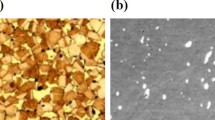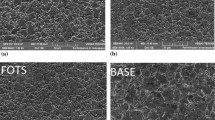Abstract
A self-assembled 1-dodecanethiol film assisted with the preferential adhesion of polydopamine was prepared on the non-etching 304 stainless steel surfaces by a simple dip-coating method. The formation and surface structure of the film were characterized by water contact angle measurement, atomic force microscopy (AFM), and X-ray photoelectron spectroscopy (XPS). The corrosion behavior of the complex films was evaluated by Tafel polarization curve and electrochemical impedance spectroscopy (EIS). The excellent corrosion resistance property could be attributed to the compact hybrid film structure and superior seawater stability for modified 304 stainless steel surface.
Similar content being viewed by others
References
Alivisatos P. The use of nanocrystals in biological detection. Nat Biotechnol, 2004, 22: 47–52
Chen S G, Liu T, Yin Y S. Stable biomimetic film on Fe3Al surface for corrosion resistance in seawater. Sci China Ser E-Tech Sci, 2008, 51: 975–978
Harris M T, Whimey G M, Croll L M. The electrodeposition of Ni-Fe-Cr alloys for magnetic thin film applications. J Electrochem Soc, 1995, 142: 1031–1034
Fouda A S, Ellithy A S. Inhibition effect of 4-phenylthiazole derivatives on corrosion of 304L stainless steel in HCl solution. Corros Sci, 2009, 51: 868–875
Falconnet D, Pasqui D, Park S, et al. A novel approach to produce protein nanopatterns by combining nanoimprint lithography and molecular self-assembly. Nano Lett, 2004, 4: 1909–1914
Videla H A. Biofilms and corrosion interactions on stainless steel in seawater. Int Biodeterior Biodegrad, 1994, 34: 245–257
Chen G X, Beving D E, Bedi R S, et al. Initial bacterial deposition on bare and zeolite-coated aluminum alloy and stainless steel. Langmuir, 2009, 25: 1620–1626
Sheng X, Ting Y P, Pehkonen S O. Evaluation of an organic corrosion inhibitor on abiotic corrosion and microbiologically influenced corrosion of mild steel. Ind Eng Chem Res, 2007, 46: 7117–7125
Da S S, Basseguy R, Bergel A. Electron transfer between hydrogenase and 316L stainless steel: Identification of a hydrogenase-catalyzed cathodic reaction in anaerobic MIC. J Electroanal Chem, 2004, 561: 93–102
Shi X M, Yang Z X, Tuan A N, et al. An electrochemical and microstructural characterization of steel-mortar admixed with corrosion inhibitors. Sci China Ser E-Tech Sci, 2009, 52: 52–66
Shih C C, Shih C M, Su Y Y, et al. Effect of surface oxide properties on corrosion resistance of 316L stainless steel for biomedical applications. Corros Sci, 2004, 46: 427–441
Shustak G, Domb A J, Mandler D. Preparation and characterization of n-alkanoic acid self-assembled monolayers adsorbed on 316L stainless steel. Langmuir, 2004, 20: 7499–7506
Yuan S J, Pehkonen S O, Ting Y P, et al. Inorganic-organic hybrid coatings on stainless steel by layer-by-layer deposition and surface-initiated atom-transfer-radical polymerization for combating biocorrosion. ACS Appl Mater Interface, 2009, 1: 640–652
Zhu G Q, Huang X J, Hojamberdiev M, et al. Preparation of Sb2S3 film on functional organic self-assembled monolayers by chemical bath deposition. J Mater Sci, 2011, 46: 700–706
Decher G. Fuzzy nanoassemblies: Toward layered polymeric multicomposites. Science, 1997, 277: 1232–1237
Whaley S R, Hu E L, Barbara P F, et al. Borrowing ideas from nature: Peptide specific binding to gallium arsenide. Nature, 2000, 405: 665
Tao Y, Yi D Q, Zhu B J, et al. Direct hydrothermal electrochemical preparation of diamond-like carbon films on substrates. J Mater Sci, 2011, 46: 1136–1138
Hao W C, Pan F, Wang T M. Photocatalytic activity TiO2 granular films prepared by layer-by-layer self-assembly method. J Mater Sci, 2005, 40: 1251–1253
Philippe L, Heiss C, Michler J. Electroplating of stainless steel. Chem Mater, 2008, 20: 3377–3382
Liu P S, Liang K M. Review functional materials of porous metals made by P/M electroplating and some other techniques. J Mater Sci, 2001, 36: 5059–5072
Caro A, Humblot V, Méthivier C, et al. Grafting of lysozyme and/or poly(ethylene glycol) to prevent biofilm growth on stainless steel surfaces. J Phys Chem B, 2009, 113: 2101–2109
Shustak G, Domb A J, Mandler D. n-alkanoic acid monolayers on 316L stainless steel promote the adhesion of electropolymerized polypyrrole films. Langmuir, 2006, 22: 5237–5240
Ignatova M, Voccia S, Gabriel S, et al. Stainless steel grafting of hyperbranched polymer brushes with an antibacterial activity: Synthesis, characterization, and properties. Langmuir, 2009, 25: 891–902
Kingshott P, Wei J, Bagge D R, et al. Covalent attachment of poly (ethylene glycol) to surfaces, critical for reducing bacterial adhesion. Langmuir, 2003, 19: 6912–6921
Wei J, Ravn D B, Gram L, et al. Stainless steel modified with poly (ethylene glycol) can prevent protein adsorption but not bacterial adhesion. Colloids Surf B, 2003, 32: 275–291
Yu M, Hwang J, Deming T J. Role of l-3, 4-dihydroxyphenylalanine in mussel adhesive proteins. J Am Chem Soc, 1999, 121: 5825–5826
Lee H, Rho J, Holmburg K, et al. Facile conjugation of biomolecules onto surfaces via mussel adhesive protein inspired coatings. Adv Mater, 2009, 21: 431–434
Fan X W, Lin L J, Dalsin J L, et al. Biomimetic anchor for surface-initiated polymerization from metal substrates. J Am Chem Soc, 2005, 127: 15843–15847
Lee H, Dellatore S M, Miller W M, et al. Mussel-inspired surface chemistry for multifunctional coatings. Science, 2007, 318: 426–430
Yu M, Deming T J. Synthetic polypeptide mimics of marine adhesives. Macromolecules, 1998, 31: 4739–4745
Shultz M D, Reveles J U, Khanna S N, et al. Reactive nature of dopamine as a surface functionalization agent in iron oxide nanoparticles. J Am Chem Soc, 2007, 129: 2482–2487
McWhirter M J, Bremer P J, Lamont L L, et al. Siderophore-mediated covalent bonding to metal (oxide) surfaces during biofilm initiation by pseudomonas aeruginosa bacteria. Langmiur, 2003, 19: 3575–3577
Rajh T, Saponjic Z, Liu J, et al. Charge transfer across the nanocrystalline-DNA interface: Probing DNA recognition. Nano Lett, 2004, 4: 1017–1023
Chen S G, Chen Y, Lei Y H, et al. Novel strategy in enhancing stability and corrosion resistance for hydrophobic functional films on copper surfaces. Electrochem Commun, 2009, 11: 1675–1682
Liu T, Yin Y S, Chen S G, et al. Super-hydrophobic surfaces improve corrosion resistance of copper in seawater. Electrochim Acta, 2007, 52: 3709–3713
Liu T, Chen S G, Cheng S, et al. Corrosion behavior of super-hydrophobic surface on copper in seawater. Electrochim Acta, 2007, 52: 8003–8007
Gu G T, Zhang Z J, Dang H X, et al. Preparation of hydrophobic thin films based on PTFE/acrylic resin/SiO2 complex. J Mater Sci, 2004, 39: 5613–5615
Prucker O, Ruhe J. Polymer layers through self-assembled monolayers of initiators. Langmuir, 1998, 14: 6893–6898
Anirban G, Anil K B. Effect of polar modification on morphology and properties of styrene-(ethylene-co-butylene)-styrene triblock copolymer and its montmorillonite clay-based nanocomposites. J Mater Sci, 2009, 44: 903–918
Cao B, Zhu C S. Preparation of self-sustained film by Sol-gel method. Sci China Ser E-Tech Sci, 1999, 42: 88–93
Behpour M, Ghoreishi S M, Niasari M S, et al. Evaluating two new synthesized S-N Schiff bases on the corrosion of copper in 15% hydrochloric acid. Mater Chem Phys, 2008, 107: 153–156
Khaled K F. Guanidine derivative as a new corrosion inhibitor for copper in 3% NaCl solution. Mater Chem Phys, 2008, 112: 104–111
Vreugdenhil A J, Gelling V J, Woods M E, et al. The role of crosslinkers in epoxy-amine crosslinked silicon Sol-Gel barrier protection coatings. Thin Solid Films, 2008, 517: 538–543
Qian M, Soutar A M, Tan X H, et al. Two-part epoxy-siloxane hybrid corrosion protection coatings for carbon steel. Thin Solid Films, 2009, 517: 5237–5242
Ma H, Chen S, Niu L, et al. Inhibition of copper corrosion by several Schiff bases in aerated halide solutions. J Appl Electrochem, 2002, 32: 65–72
Author information
Authors and Affiliations
Corresponding author
Rights and permissions
About this article
Cite this article
Chen, Y., Chen, S., Chen, Y. et al. Surface analysis and electrochemical behaviour of the self-assembled polydopamine/dodecanethiol complex films in protecting 304 stainless steel. Sci. China Technol. Sci. 55, 1527–1534 (2012). https://doi.org/10.1007/s11431-012-4788-7
Received:
Accepted:
Published:
Issue Date:
DOI: https://doi.org/10.1007/s11431-012-4788-7




